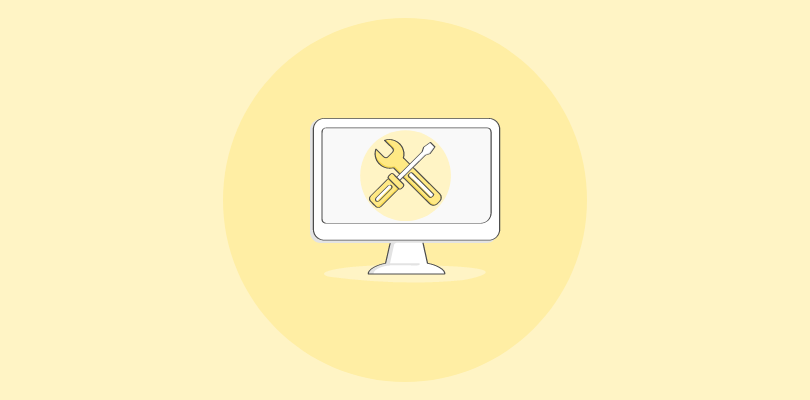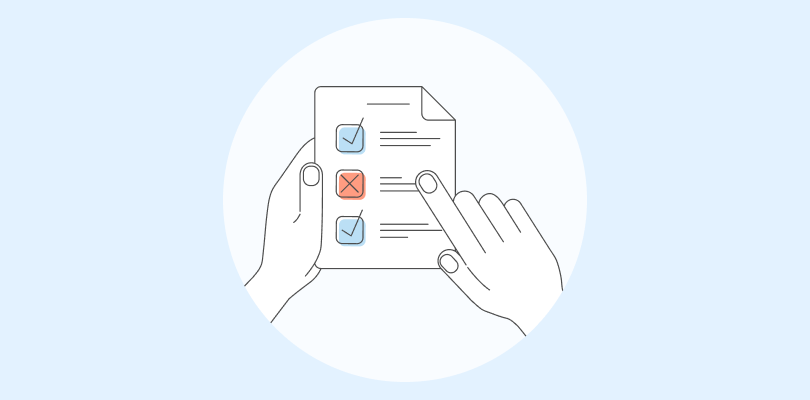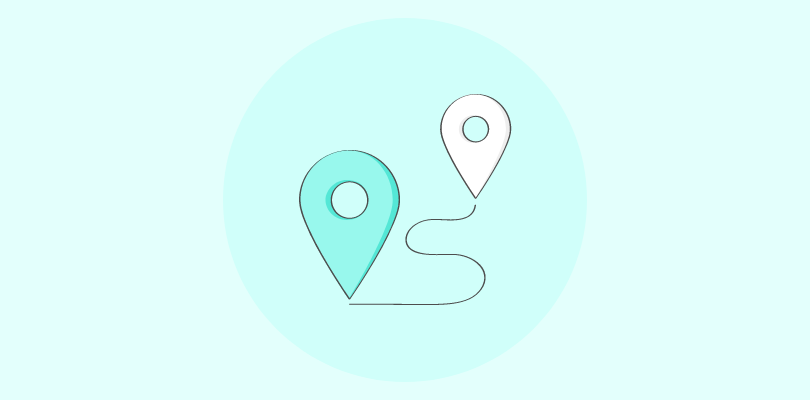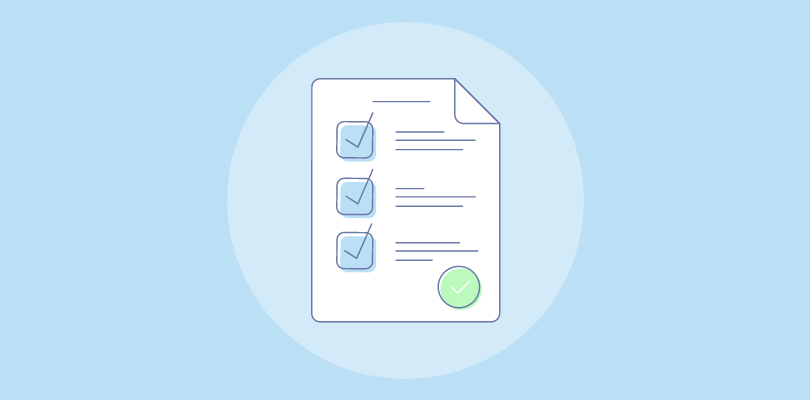Whenever there is talk about educational assessments, students writing exams is the first image to float in many people’s minds. Well, the real picture is quite different. Assessments are much more than just tests. They are also about exploring and measuring learning in different ways.
Assessments help identify what students have learned, what they need to learn next, and how they can learn more effectively. They also help teachers plan, improve, and evaluate their educational programs.
But what is assessment in education, and why is it important for teachers and students?
In this blog post, I’ll answer these questions and more by taking you on a journey through the fascinating world of educational assessments.
Definition and Purpose of Educational Assessment
Educational assessment is the process of collecting and analyzing evidence of learning in different settings and contexts. It helps teachers, students, parents, and other stakeholders understand what learners know and can do, as well as identify their strengths and areas for improvement.
Almost every educational environment today uses assessments, whether end-of-chapter quizzes and final exams or large-scale standardized testing, such as the Common Core, SAT, and GRE tests.
Educational assessments can take many forms:
- They may involve formal tests or performance-based activities.
- They may be administered online or be paper-based.
- They may be objective (requiring a single correct answer) or subjective (requiring an open-ended answer, such as in an essay).
- They may be formative (carried out at various points during an educational course) or summative (carried out at the end of a course).
Watch: How to Create an Assessment Online
The purpose of educational assessment is to enhance learning and improve educational quality by enabling educators to make informed decisions that support learners’ growth and development.
Using education assessments, educators can:
- Align instruction with learning goals and standards
- Provide feedback and guidance to learners
- Track learners’ progress and achievement over time
- Adjust teaching strategies based on learners’ needs
- Motivate and engage learners in their learning
- Evaluate the effectiveness of educational programs
- Communicate learners’ progress and achievement to stakeholders
- Foster a culture of growth and accountability
Now that we know the definition and meaning of assessment in education and its aims, let us dive into the various types of assessments that educators can use to measure and enhance learning outcomes.
Different Types of Assessments in Education
Teachers and schools use different types of education assessments to check how well students learn. Some of these types are fixed by the system, but others are the teachers’ choice.
1. Diagnostic Assessment
What do you do before teaching your students a new topic? Do you just dive into the lesson and hope for the best? Or do you find out what students already know and can do and what they need to learn?
If you choose the latter option, you’re using diagnostic assessment.
Diagnostic assessment checks your students’ prior knowledge and skills before you begin a new lesson or unit. It helps you identify their strengths and weaknesses and any misconceptions or gaps in their understanding.
This way, you can plan your instruction to suit their needs and abilities and avoid wasting time on things they already know or don’t need to know.
There are many tools and techniques you can use for diagnostic assessment, such as:
- Pre-tests: These are short quizzes or tests covering the main concepts or skills you will teach in the lesson or unit. They give you and your students a clear picture of how much they already know and what they still need to learn.
- Surveys or questionnaires: These are questions you ask your students to rate their confidence or interest in the topic or to share their opinions or experiences. They give you and your students an insight into their attitudes and motivations toward learning.
- Checklists: These are lists of skills or concepts your students are expected to master by the end of the lesson or unit. They give you and your students a way of tracking their progress and setting goals.
Watch: How to Create an Online Quiz in Under 5 Mins
Diagnostic assessment is useful not only for teachers but also for students. It helps them become aware of their learning and set realistic expectations. It also helps them start the learning process on the same page as you and work towards achieving the desired outcomes.
2. Formative Assessment
Formative assessments are used throughout the educational process to identify problem areas and improve teaching and learning. They are not meant to grade students but to provide feedback and guidance for both students and teachers.
Some formative educational assessment examples are:
- Quizzes: These are short tests that check students’ understanding of key concepts or skills. They can be given at the beginning, middle, or end of a lesson, graded or ungraded.
- Exit tickets: These are short questions or tasks that students complete at the end of a lesson to show what they have learned or still have questions about.
- Think-pair-share: This cooperative learning strategy involves students thinking individually about a question or problem, then discussing it with a partner, and finally sharing their ideas with the whole class.
- Self-assessment: This process involves students reflecting on their learning and progress using rubrics, checklists, or portfolios.
- Peer feedback: This process involves students giving and receiving constructive comments and suggestions from their classmates.
- Flashcards: Cards with questions on one side and answers on the other
Formative assessments offer many benefits for students and teachers. For students, formative assessments can:
- Increase their motivation and engagement in learning
- Help them identify their strengths and weaknesses
- Help them monitor their learning and set goals
- Help them develop metacognitive and self-regulation skills

For teachers, formative assessments can:
- Provide valuable information about students’ learning needs and progress
- Help them adjust their instruction and provide differentiated support
- Help them communicate effectively with students and parents
- Help them evaluate the effectiveness of their teaching methods and materials
3. Summative Assessment
Summative assessments are used at the end of a learning block, such as a unit, a semester, or a year, to evaluate students’ achievement of the learning goals. They are designed to measure the outcomes that students are expected to demonstrate at the end of the instruction.
They also provide feedback on the effectiveness of the learning process, the quality of the instruction, and the long-term impact of the learning.
Some summative educational assessment examples are:
- Final exams: These comprehensive tests cover the entire content and skills taught in a course or a grade level. They can be written or oral and include multiple-choice, short-answer, or essay questions.
- Projects: These are complex tasks that require students to apply their knowledge and skills to create a product or a solution. They can be individual or group-based and involve research, design, or presentation.
- Portfolios: These are collections of students’ work and achievements over time. They can include samples of their best work, reflections, feedback, and self-evaluations.
- Standardized tests: These are tests that are administered and scored consistently across schools or districts. They can be used to measure students’ proficiency in specific subjects or skills or to compare their performance with other students or groups.
Watch: How to Create Online Tests or Exams
4. Standardized Assessments
Standardized assessments, or standardized tests, are given and scored consistently across large groups of students. They are often used to measure students’ proficiency in particular subjects or skills or to compare their performance.
They also help teachers and students discover why a student might be struggling, succeeding, or accelerating on their grade-level standards and plan the next step in their assessment for learning.
Some standardized educational assessment examples are grade-level tests and the SAT.
These tests are usually objective, with question types like multiple-choice and true-or-false. However, some tests also include subjective items, like short-answer and essay questions. They can be given in person or online.
Watch: Question Types for Online Learning & Assessment
5. Performance-Based Assessments
Performance-based assessments require students to demonstrate their skills and knowledge in a specific domain, such as writing an essay or delivering a speech. They evaluate students’ ability to use what they have learned in a meaningful way rather than just memorizing facts or information.
This type of assessment is becoming more popular as competency-based education gains traction. Competency-based education emphasizes students’ mastery of specific outcomes rather than following a fixed curriculum.
Performance-based assessments are usually conducted face-to-face, but they can also be done online in some cases. For example, students enrolled in a web development or graphic design course may showcase their learning by creating a digital project using online tools.
6. Norm & Criterion-Referenced Assessments
Referenced assessments are assessments that compare students’ results to a particular standard. There are two types of referenced assessments: norm-referenced and criterion-referenced.
Norm-referenced assessments compare students’ performance with the performance of a large group of similar students, whose score is referred to as the norm.
For example, imagine all students in Grade 9 take the same norm-referenced test. If a particular student scores in the 91st percentile, that means they did better than 90% of the sample serving as the norm.
Norm-referenced tests are often used to rank or classify students according to their relative abilities or achievements.
Criterion-referenced assessments are tests that measure students’ performance against a set of standards or criteria, which are based on the curriculum and learning objectives.
For example, students in a class may be required to score 80% or higher on a particular test before moving on to the next concept.
Criterion-referenced tests are often used to determine whether students have achieved the expected learning outcomes or demonstrated proficiency in a certain skill or subject.
7. Ipsative Assessments
The term “ipsative” comes from the Latin word “ipse” which means “of the self.” Ipsative assessment is a type of assessment that compares a student’s performance with their previous performance rather than with the performance of others or with a set of criteria.
Ipsative assessment measures a student’s personal improvement and progress over time rather than their absolute level of achievement. It can also help students identify their strengths and weaknesses and set realistic goals.
Here’s a table comparing norm-referenced, criterion-referenced, and ipsative assessments:
| Criteria | Norm-referenced | Criterion-referenced | Ipsative |
| Purpose | To compare the performance of students to each other | To measure the performance of students against a preset standard or criteria | To measure the progress of students against their own previous performance |
| Score interpretation | Based on how the student ranks relative to other students (e.g., percentiles, z-scores, T-scores) | Based on how the student meets or exceeds a certain level of mastery (e.g., cut scores, performance categories) | Based on how the student improves or declines over time |
| Content | May cover a broad range of skills and knowledge from multiple sources | Usually focused on a specific set of skills and knowledge from a defined curriculum | May cover the personal strengths and weaknesses of the student |
| Difficulty | May vary depending on the ability level of the group being tested | Should be consistent and aligned with the learning objectives | Should be challenging but realistic for the student |
| Use | Often used for selection, placement, or grading purposes | Often used for diagnostic, formative, or summative purposes | Often used for motivational, developmental, or feedback purposes |
8. Alternative Assessments
Alternative assessments are different from traditional tests, such as multiple-choice or true-or-false questions. They can include various tasks and activities that allow students to demonstrate their learning in different ways. They are often more flexible and student-centered than traditional tests.
Some alternative educational assessment examples are:
- Observations: Teachers watch and record students’ behaviors, actions, and interactions in the classroom or other settings.
- Essays: Students write responses expressing their thoughts, opinions, or arguments on a topic or question.
- Performance tasks: Students perform a task that requires them to apply their knowledge and skills to create a product or a solution.
- Exhibitions and demonstrations: Students display or present their work or performance to the class or an audience.
- Portfolios: Students collect and showcase their work and achievements over time.
- Journals: Students record their learning experiences and thoughts.
- Project work: Students work individually or collaboratively on a task that involves planning, researching, designing, and producing a product or a solution related to a real-world problem or issue.
- Interviews: Teachers ask, and students answer questions about a topic or problem orally. They can do this in-person or via video interview mediums, such as video conferencing tools and online quizzes.
Watch: How to Create a Video Interview Quiz
9. Authentic Assessments
Authentic education assessments are alternative assessments that measure students’ ability to apply their knowledge and skills to real-world situations and problems.
They require students to perform complex and action-oriented tasks that reflect the standards and expectations of the discipline or profession. They also require students to use higher-order critical thinking skills.
Some examples of authentic educational assessment tasks are:
- Projects: Students plan, research, design, and produce a product or a solution related to a real-world problem or issue.
- Portfolios: Students collect and showcase their work and achievements over time and reflect on their learning process and outcomes.
- Real-world applications: Students apply their knowledge and skills to authentic contexts or situations they may encounter in their personal or professional lives.
Authentic assessments have many benefits for deeper learning and skill development. For example, they can:
- Help students connect their learning to real-life situations and problems by simulating authentic contexts or scenarios
- Help students develop transferable skills for their future careers or studies by requiring them to use higher-order, critical thinking skills
- Help teachers evaluate the effectiveness of their teaching methods and materials by measuring the impact of their instruction on students’ learning outcomes
Now that we have discussed the various types of educational assessments and their purposes, let’s understand their importance in the education system and their role in improving teaching and learning.
What Is the Importance of Assessments in the Education System?
Educational assessments are powerful tools that can enhance learning and teaching when done well. Some of the benefits of a good educational assessment are:
- Progress monitoring: Assessments help educators track students’ progress and identify their strengths and weaknesses so that they can provide appropriate support and intervention.
- Feedback: They provide feedback to students about their performance, which they can use to monitor their learning and set goals for improvement.
- Motivation: They motivate students, as they know they will be assessed on what they have learned and how well they have learned it.
- Alignment: They help educators align their instruction with the learning objectives and outcomes and determine the most effective strategies and methods to help students achieve them.
- Curriculum improvement: They can improve the curriculum by identifying gaps, redundancies, or inconsistencies in the content and skills taught.
- Evaluation: They can be used to evaluate teachers’ and school systems’ performance and the impact of different teaching practices on student learning.
- Differentiation: They help educators differentiate their instruction and assessment according to their students’ diverse needs and abilities and provide them with multiple ways to demonstrate their learning.
These are the benefits of “good” educational assessment, but what makes assessments good?
What Makes an Educational Assessment “Good”?
A good educational assessment follows three basic principles of quality:
1. Assessments should be aligned with defined objectives and outcomes
Clarity about the desired knowledge and skills students are expected to learn and demonstrate is essential for designing and implementing effective assessments. The assessments should match the learning objectives and outcomes and measure the extent to which students have achieved them.
2. Assessments should be valid
Validity refers to how well an assessment measures what it claims to measure. Different types of assessments are suitable for different types of learning, and they should be chosen accordingly.
For example, a multiple-choice test may be a valid way to assess students’ knowledge of historical facts but not their research skills.
3. Assessments should be reliable
Reliability measures how consistent and accurate an assessment is. A reliable assessment should produce similar results when administered under the same conditions and minimize errors and biases that may affect the scores.
For example, a reliable assessment should have clear instructions, fair scoring criteria, and adequate time limits.
We’ve gone through the basics of educational assessment and how quizzes are often used for it. But did you know you can create quizzes online easily? Before finishing this post, let’s check out the steps for making an online educational quiz.
How to Create an Educational Assessment Quiz Online
Here are the steps for creating an online educational assessment quiz. We’ve taken ProProfs Quiz Maker as an example here.
Step 1: Choose a quiz type.
You can create a scored or personality quiz depending on your needs.
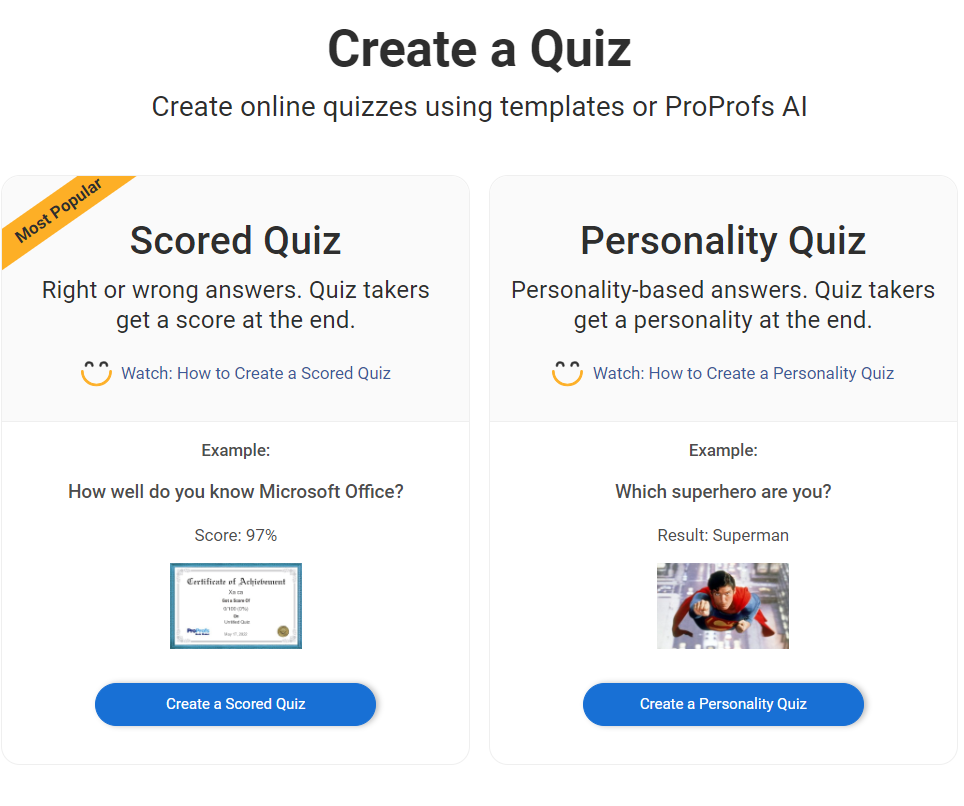
Step 2: Pick a template, create a quiz with AI, or make one from scratch.
You can pick from thousands of educational quiz templates, generate a quiz in seconds with ProProfs AI, or start from the ground up.
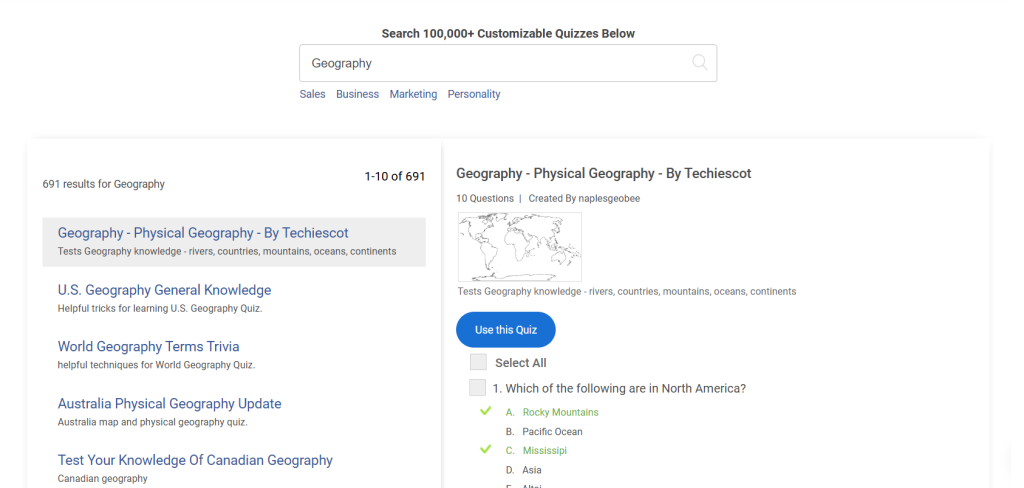
Step 3: Create or import your quiz questions.
You can import questions from a bank of over a million ready-to-use questions or create your own quiz questions. You can also add images and videos to make your quiz more engaging.
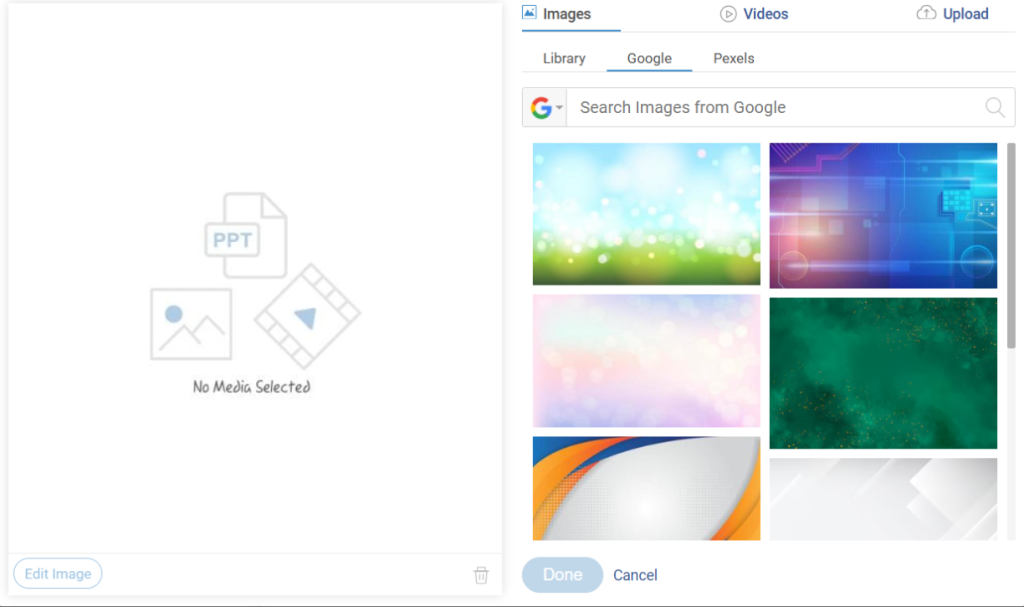
You can choose from 15+ question types, including multiple-choice, fill-in-the-blanks, matching, hotspot, video response, and more.
Watch: How to Create a Quiz Using Question Bank & Templates
Step 4: Customize the look and settings of your quiz.
You can change your quiz’s theme, colors, fonts, background image, and more to customize its look and feel and enhance its visual appeal.
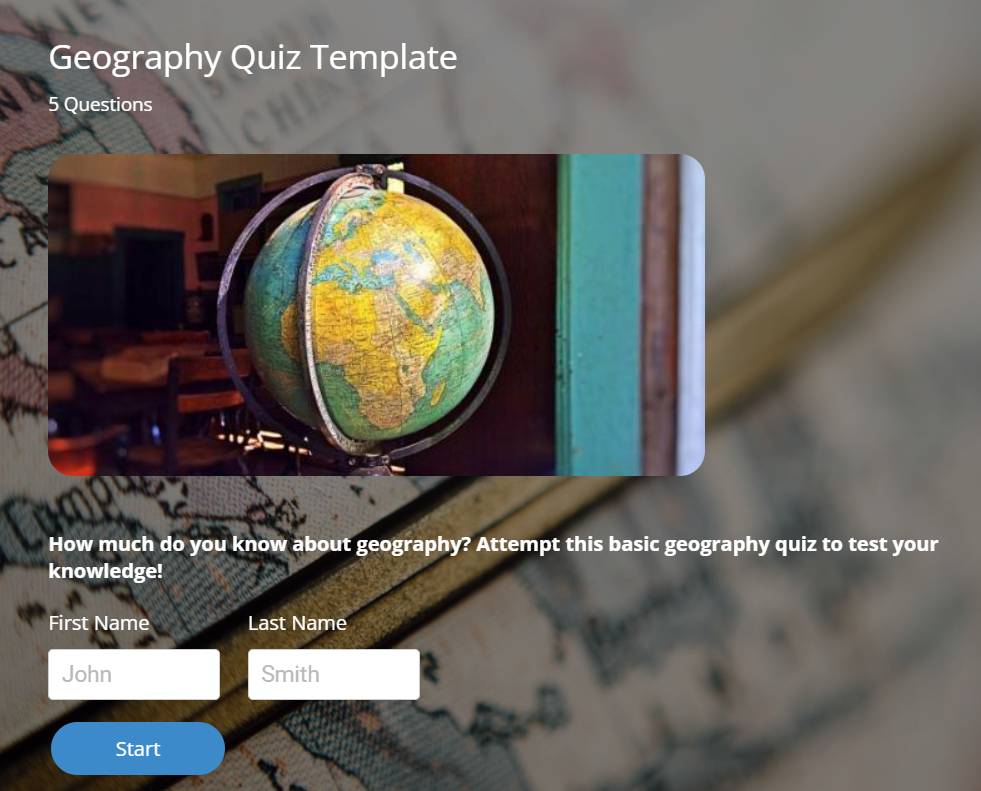
You can also adjust the settings for scoring, feedback, security, cheating prevention, and more.
Watch: How to Configure Online Quiz Settings & Theme
Step 5: Share your quiz with your students.
You can embed your quiz on your website or blog, share it on social media or email, or generate a link or QR code for your quiz.
Watch: How to Share Online Quizzes With Learners
Check our comprehensive online assessment guide to learn more about creating online assessment quizzes for education.
How to Measure Assessment Effectiveness in Education
Crafting assessments is just the first step. To truly harness their power for learning, we need to understand their impact. But how do we really know if they’re hitting the mark? It’s not always straightforward, but here’s a path to explore:
1. Dive Deep Into Student Performance
Don’t just glance at the overall scores. Unearth the patterns – where are students excelling? Where are they stumbling? Are there surprising trends in different groups? This granular view reveals if your assessments are capturing student understanding.
2. Tap Into the Student Voice
Ask students directly about their assessment experience. Did the questions resonate with them? Did they feel the assessment was a fair reflection of their learning? Their honest feedback can offer great insights and uncover blind spots you might have missed.
3. Scrutinize Every Assessment Item
Take a magnifying glass to each question or task. Do they genuinely align with what you aimed to teach? Is the wording clear and bias-free? This meticulous analysis helps weed out questions that are overly challenging, deceptively simple, or just plain confusing.
4. Connect the Dots With Other Measures
See how assessment results relate to other signs of learning – classroom discussions, homework assignments, and standardized tests. Having a broader perspective lets you gauge if the assessment is painting a complete picture of student progress.
5. Close the Loop With Actionable Insights
The ultimate test of an assessment lies in its impact on teaching and learning. Transform those data points into action. Identify where students need more support, refine your teaching strategies, and provide feedback that truly resonates.
Boost Teaching Outcomes With Educational Assessments
Educational assessment is a vital process that helps teachers, students, and other stakeholders measure and improve learning outcomes. It can take various forms, such as formative, summative, diagnostic, and more. Educators can gain a comprehensive picture of students’ strengths, weaknesses, progress, and needs using various assessment methods and tools.
One of the most effective tools for creating online assessments is ProProfs Quiz Maker. ProProfs allows you to create quizzes and exams in seconds using AI and templates and ask questions in 20+ different ways. You can customize your quizzes with multimedia, themes, custom settings, and feedback options. ProProfs Quiz Maker helps you make learning fun and interactive for your students.
Frequently Asked Questions
What are the functions of education assessment?
Education assessment helps track student progress, identify learning gaps, and improve teaching methods. It measures learning outcomes, provides feedback, supports curriculum planning, and ensures accountability in education.
FREE. All Features. FOREVER!
Try our Forever FREE account with all premium features!

